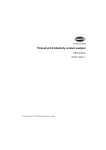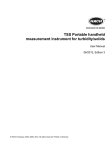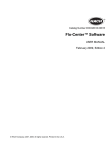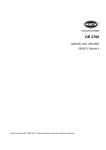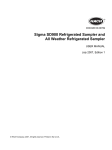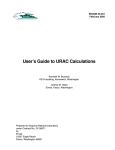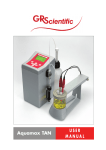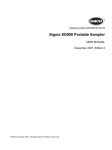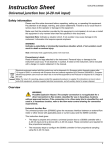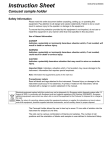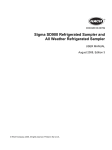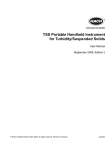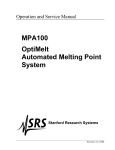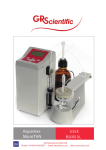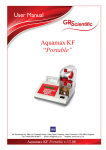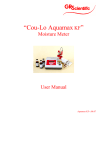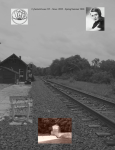Download TitraLab Karl Fischer
Transcript
DOC022.52.90357 Karl Fischer Titrator USER MANUAL 01/2013, Edition 2A © Hach Company, 2011, 2013. All rights reserved. Printed in Germany. Table of contents Section 1 Specifications ........................................................................................................................ 5 Section 2 General information............................................................................................................... 7 2.1 Safety information............................................................................................................................... 7 2.1.1 Warning labels ........................................................................................................................... 7 2.1.2 Chemical and biological safety .................................................................................................. 8 2.2 Overview of product............................................................................................................................ 8 2.3 Front and back view............................................................................................................................ 9 Section 3 Installation ............................................................................................................................ 11 3.1 Unpack the instrument...................................................................................................................... 11 3.2 Scope of delivery .............................................................................................................................. 11 3.3 Operating environment ..................................................................................................................... 13 3.4 Installation......................................................................................................................................... 13 3.4.1 Installation of the burette.......................................................................................................... 13 3.4.2 Installation of the titration stand ............................................................................................... 14 3.4.2.1 Electrical connection of the magnetic stirrer ................................................................... 15 3.4.3 Installation of tubes .................................................................................................................. 16 3.4.3.1 Removal of protective stickers ........................................................................................ 16 3.4.3.2 Connection of tubes for KF titrant ................................................................................... 16 3.4.3.3 Connection of tubes for solvent ...................................................................................... 17 3.4.3.4 Connection of tubes for waste bottle............................................................................... 18 3.4.4 Electrode.................................................................................................................................. 19 3.4.5 Power supply, external............................................................................................................. 20 3.5 Keypad.............................................................................................................................................. 21 3.6 Reagents .......................................................................................................................................... 23 3.6.1 Chemical reactions .................................................................................................................. 23 3.6.2 Titrant and solvents.................................................................................................................. 23 3.6.2.1 One-component reagents ............................................................................................... 23 3.6.2.2 Two-component reagents ............................................................................................... 23 Section 4 Operation.............................................................................................................................. 25 4.1 Switch on the instrument .................................................................................................................. 25 4.2 Startup .............................................................................................................................................. 25 4.2.1 Language and data output setting ........................................................................................... 25 4.2.1.1 Change the language setting .......................................................................................... 25 4.2.1.2 Change the data output setting....................................................................................... 25 4.2.2 First steps after installation ...................................................................................................... 25 4.3 Menu structure.................................................................................................................................. 25 3 Table of contents 4.4 General information on KF titration ...................................................................................................29 4.4.1 Individual titration steps............................................................................................................29 4.4.2 Titration cell ..............................................................................................................................29 4.4.3 Stirring speed ...........................................................................................................................29 4.4.4 Removal of bubbles..................................................................................................................29 4.4.5 Standby cycle ...........................................................................................................................30 4.4.6 Standard water solutions..........................................................................................................30 4.4.7 Empty the titration cell ..............................................................................................................30 4.5 Calibration .........................................................................................................................................30 4.6 Titration .............................................................................................................................................31 4.7 Manual component activation............................................................................................................33 4.7.1 Burette......................................................................................................................................33 4.7.2 Pumps ......................................................................................................................................33 4.7.3 Stirrer........................................................................................................................................33 4.8 Programming.....................................................................................................................................33 4.8.1 Configuration of the calibration program ..................................................................................33 4.8.2 Configuration of the titration programs .....................................................................................34 4.9 Data log .............................................................................................................................................35 4.10 Printer/computer..............................................................................................................................35 4.11 System ............................................................................................................................................35 4.12 Default settings ...............................................................................................................................36 Section 5 Maintenance..........................................................................................................................37 5.1 Maintenance schedule ......................................................................................................................37 5.2 Power off the instrument ...................................................................................................................37 5.3 Clean the burette...............................................................................................................................38 5.4 Clean the electrode ...........................................................................................................................38 5.5 Replace pump tubes .........................................................................................................................38 Section 6 Troubleshooting ...................................................................................................................41 6.1 Error messages ................................................................................................................................41 6.2 Incorrect results.................................................................................................................................42 Section 7 Replacement parts and accessories ................................................................................43 7.1 Replacement parts ............................................................................................................................43 7.2 Accessories .......................................................................................................................................43 Section 8 Contact information ............................................................................................................45 Appendix A Weigh the sample .............................................................................................................47 Appendix B Volume test .......................................................................................................................49 8.1 Required equipment ..........................................................................................................................49 8.2 Execution ..........................................................................................................................................50 Index .......................................................................................................................................................51 4 Section 1 Specifications These are subject to change without notice! Performance specifications Measuring principle Volumetric titration according to Karl Fischer method for water content determination Measuring range Water content between 100 ppm or 0.01% and 100 % H2O Factor 0 to 99,999 Resolution 0–10 % H2O 0.001 % Resolution 10–100 % H2O 0.01 % Programs 4 KF titration programs and 1 calibration program Languages English, Spanish, French and Italian Data logger Last 50 data records Memory Date/time DD-MM-YYYY Header text 2 lines of 40 characters each Users Names of 4 users Comment text 8 lines of 40 characters each RS 232 C interface Communication parameters for scales Display 128 × 64 pt, backlit liquid crystal display Keypad 7 membrane keys, splash-proof, PET, >6 million key-presses Burette Resolution 1/40,000 of nominal syringe value (at least 0.001 mL) Dosing accuracy ≤ 0.2 % (if volume >10 % of syringe volume) Reproducibility of dosing ±0.1 % (if volume >10 % of syringe volume) Material of syringe Borosilicate glass and PTFE, 5 mL Material of electrovalve Material with liquid contact: PTFE and KEL-F Material of tubes Reagent tubes Peristaltic pump Inputs and outputs Black tubes, PTFE White tubes, PTFE Volumetric flow 170 mL/min ± 15 % Tube Novoprene, internal diameter 3.2 mm Measuring electrode BNC connector Magnetic stirrer RCA connector (cinch) External keypad Mini-DIN connector RS232 for computer or printer Telephone connector (RJ9) RS232 for scales Telephone connector (RJ9) Power supply, external 24 VAC, 1.25 A, 30 VA 5 Specifications Dimensions of measuring instrument and environmental conditions Enclosure material ABS and enameled steel Mass approximately 4 kg Dimensions 130 × 160 × 300 mm Working temperature +15 to +40 °C (+60 to +104 °F) Storage temperature –10 to +50 °C (+14 to +122 °F) Air humidity <80 % relative humidity, non-condensing Warranty Warranty 6 2 years Section 2 2.1 General information Safety information Please read the entire user manual carefully before the equipment is unpacked, set up or put into operation. Pay attention to all danger and warning statements. Failure to do so could result in serious injury to the operator or damage to the equipment. To make sure that the protection provided by this instrument is not impaired, do not use or install this instrument in any manner other than that specified in these operating instructions. DANGER Indicates a potentially or imminently hazardous situation that, if not avoided, results in death or serious injury. WA R N I N G Indicates a potentially or imminently hazardous situation that, if not avoided, could result in death or serious injury. CAUTION Indicates a potentially hazardous situation that may result in minor or moderate injury. NOTICE Indicates a situation that, if not avoided, could result in damage to the instrument. Information that requires special emphasis. Note: Information that supplements points in the main text. 2.1.1 Warning labels Read all labels and tags attached to the instrument. Personal injury or damage to the instrument could occur if not observed. For symbols applied to the instrument, corresponding warnings are provided in the user manual. This symbol, if noted on the instrument, references the instruction manual for operation and/or safety information. This symbol may be found on an enclosure or barrier within the product and indicates a risk of electrical shock and/or death by electrocution. Electrical equipment marked with this symbol may not be disposed of in European domestic or public disposal systems after August 12, 2005. In conformity with European local and national regulations, European electrical equipment users must now return old or end-of life equipment to the manufacturer for disposal at no charge to the user. Note: For return for recycling, please contact the equipment manufacturer or supplier for instructions on how to return end-of-life equipment, manufacturer-supplied electrical accessories, and all auxiliary items for correct disposal. 7 General information 2.1.2 Chemical and biological safety DANGER Potential danger in the event of contact with chemical/biological materials. Handling chemical samples, standards and reagents can be dangerous. Familiarize yourself with the necessary safety procedures and the correct handling of the chemicals before the work and read and follow all relevant safety data sheets. Normal operation of this instrument may involve the use of hazardous chemicals or biologically harmful samples. 2.2 • Observe all cautionary information printed on the original solution containers and safety data sheet prior to their use. • Dispose of all consumed solutions in accordance with national regulations and laws. • Select the type of protective equipment suitable to the concentration and quantity of the dangerous material at the respective work place. Overview of product Volumetric titration according to the Karl Fischer (KF) method is an important method used to determine water content. The method is routinely applied in many fields, including the chemical, petrochemical, pharmaceutical and food industries. The method is also prescribed by a number of ASTM, ISO and DIN standards, as well as in regulations from European and US pharmacopeias (USP). TitraLab is suitable for all KF solvents and reagents, whereby both one and two-component reagents can be used. The instrument covers a measuring range from 100 ppm to 100 % water. Most applications are served by the four pre-programmed titration programs, though individual programs are also possible. The clearly structured user interface enables quick and simple navigation. TitraLab features two RS 232 C interfaces to enable communication with a computer, printer or external scales (for automatic weight transfer). A PS/2 interface is also provided to allow the connection of a PC keyboard for entering alphanumeric sample names. A convenient titration stand is also integrated and equipped with stirrers and pumps to add and extract the KF reagents. 8 General information 2.3 Front and back view Figure 1 Front view 1 TitraLab Karl Fischer 1S2B 7 Titrant 2 Keypad 8 Titration stand 3 Waste container 9 Magnetic stirring bar 4 Display 10 Titration cell 5 Solvent 11 Syringe cover 6 Desiccant cartridges 12 Burette 9 General information Figure 2 Back view 1 PS/2 connector for keyboard 4 Electrode connector 2 RS 232 C for external scales 5 Connector for power supply 3 RS 232 C for printer or computer 6 Connector for magnetic stirrer 10 Section 3 Installation WA R N I N G Risk of injury to eyes, skin and respiratory When working with chemicals and/or solvents, always observe the relevant accident prevention regulations and wear appropriate personal protective clothing for eye, face, hand, body and/or respiratory protection. Make sure that the system is only unpacked, assembled, connected and operated by qualified and trained personnel. 3.1 Unpack the instrument Unpack all supplied parts carefully, as they are highly sensitive in part to shock and impact. Read the user manual prior to installation and proceed exactly as described. 3.2 Scope of delivery Please check that the order is complete. If anything is missing or damaged, please contact the manufacturer or retailer. 11 Installation Figure 3 Scope of delivery 1 Titrator TitraLab Karl Fischer 1S2B 10 Titration cell 2 Burette titrant suction tube with bottle closure, DIN 45 thread, black 11 Electrode cable with BNC connector 3 2× Solvent or waste bottle tube with bottle closure, DIN 45 thread 13 Power supply, external 4 Burette titrant addition tube with antidiffuser unit, black 14 Adapter for power supply 5 2×Solvent addition or suction tube with conical adapter 15 Hardware sleeve 6 Titration stand holder 16 Syringe plunger 7 Magnetic stirrer 17 Syringe body 8 10×white O-rings for burette and pump threads 18 4×desiccant cartridge 9 10× Teflon magnetic stirring bars (12 mm × 6 mm) 12 12 Double-platinum electrode Installation 3.3 Operating environment Note the following points so that the instrument will operate correctly and have a long service life. 3.4 3.4.1 • Place the instrument firmly on an even surface. Do not push any objects under the instrument. • The ambient temperature must be 15 to 40 °C (60 to 104 °F). • The relative humidity should be less than 80 %; moisture should not condense on the instrument. • A minimum clearance of 15 cm (5.9 in.) must be ensured above and on all sides of the device; this allows the air to circulate and prevents overheating of the electric parts. The dosage arm of the stepper motor operating the syringe piston must be able to move freely. • Do not operate or store the instrument in extremely dusty, humid or wet locations. • Make sure that no liquids enter the instrument and immediately wipe away any liquids that contact the instrument. • Protect the instrument against vibrations, direct sunlight, corrosive gases as well as strong magnetic and/or electric fields. • Only use genuine replacement parts and accessories. • The instrument must be serviced by the manufacturer's service department at the prescribed intervals. Installation Installation of the burette The burette dispenses the titrant, that is the one or two-component reagent. The burette comprises the syringe, stepper motor and valve. The stepper motor and valve are already installed in the TitraLab; the syringe must be installed by the user. WA R N I N G Risk of injury to pinch points and cuts Make sure that the titrator is never used/operated without the syringe cover. Make sure that the system is only assembled by qualified and trained personnel. NOTICE Warning against system damage Make sure that the syringe is never operated without the attachment sleeve. Only use genuine replacement parts and accessories. The instrument must be serviced by the manufacturer's service department at the prescribed intervals. Note: Make sure that you do not misplace the attachment sleeve for the syringe. It is not provided with a new syringe. 1. Push the syringe piston into the syringe body. Slide the attachment sleeve fully onto the syringe so that the narrow end points toward the piston. 2. Remove the syringe cover by unscrewing it. 13 Installation 3. Point the syringe tip upward, place the syringe into the bracket such that the attachment sleeve is above the bracket. 4. With the narrow side facing down, carefully press the attachment sleeve into the bracket. Hold the attachment sleeve in the bracket and screw the syringe onto the valve from below. 5. Withdraw the piston from the syringe and place it onto the screw in the dosage arm. Hold the syringe piston and turn the attachment screw on the dosage arm into the thread in the piston. 6. Fix the syringe cover with six screws. WA R N I N G Risk of injury to eyes, skin and respiratory During the first days of system use, check the screw joint between the syringe and valve to avoid leaks and the potential escape of reagents. When working with chemicals and/or solvents, always observe the relevant accident prevention regulations and wear appropriate personal protective clothing for eye, face, hand, body and/or respiratory protection. Figure 4 Installation of the burette 1 Push the piston into the syringe body. Slide the attachment sleeve onto the syringe. 4 Place the attachment sleeve into the bracket. Screw the syringe tip onto the valve. 2 Unscrew the six screws and remove the syringe cover. 5 Screw the piston onto the dosage arm. 3 Insert the syringe into the bracket. 6 Fix the syringe cover with six screws. 3.4.2 Installation of the titration stand The titration stand consists of a holder onto which the titration cell and magnetic stirrer are attached. The actual KF titration is performed in the titration cell. Since air humidity disturbs the titration process, the titration cell is hermetically sealed by means of an airtight lid. 1. Place the magnetic stirrer onto the base of the titration stand so that it locks into place. 2. Place a magnetic stirring bar into the titration cell glass. Press the titration cell glass into the lid from below so that it locks into place. 3. Lower the titration cell onto the magnetic stirrer. Place a desiccant cartridge into the designated opening in the titration cell lid. 14 Installation Figure 5 Installation of the titration stand 1 Lock the magnetic stirrer into place on the titration stand base. 2 Place a magnetic stirring rod in the titration cell glass. Attach the titration cell glass to the lid. 3.4.2.1 3 Lower the titration cell onto the magnetic stirrer. Place a desiccant cartridge into the titration cell lid. Electrical connection of the magnetic stirrer 1. Connect the cable of the magnetic stirrer to the STIRRER port on the back of the TitraLab. The power is supplied via the TitraLab. Figure 6 1 Electrical connection of the magnetic stirrer Connect the cable of the magnetic stirrer to the STIRRER port. 15 Installation 3.4.3 Installation of tubes WA R N I N G Risk of injury to eyes, skin and respiratory During the first days of system use, check the screw joint between the syringe and valve to avoid leaks and the potential escape of reagents. When working with chemicals and/or solvents, always observe the relevant accident prevention regulations and wear appropriate personal protective clothing for eye, face, hand, body and/or respiratory protection. Make sure that the tubes are never kinked. Regularly check the system as well as all tubes and connections for leaks, condition and cleanliness. To prevent twisting of the tubes, you should always connect flange tube connections before those with grommets. 3.4.3.1 Removal of protective stickers 1. Remove the protective stickers on the burette valve and the four pump connections. 2. Make sure that the pre-installed white O-rings are not removed. 3. Check that the O-rings are in a horizontal position inside the thread. Figure 7 3.4.3.2 Position of protective stickers Connection of tubes for KF titrant 1. Screw the black burette feed tube onto the valve. 2. Screw the bottle closure of the feed tube onto the titrant bottle for the KF reagent (bottle 1 Figure 8). 3. Place the desiccant cartridge into the designated opening in the bottle closure. 4. Screw the black burette discharge tube onto the valve. 5. Insert the conical adapter with the antidiffuser unit of the discharge tube into the designated opening in the lid of the titration cell. 16 Installation Figure 8 3.4.3.3 Connection of tubes for KF titrant Connection of tubes for solvent 1. Pick up a white tube with bottle closure. 2. Screw the tube into the IN socket on pump 1. 3. Screw the bottle closure onto the solvent bottle (bottle 2 Figure 9). 4. Place the desiccant cartridge into the designated opening in the bottle closure. 5. Pick up a white tube with conical adapter. 6. Screw the tube into the OUT socket on pump 1. 7. Insert the conical adapter into the designated opening in the lid of the titration cell. 8. The tube extends approximately 3 cm (1.2 in.) into the titration cell. 17 Installation Figure 9 3.4.3.4 Connection of tubes for solvent Connection of tubes for waste bottle 1. Pick up a white tube with conical adapter. 2. Screw the tube into the IN socket on pump 2. 3. Insert the conical adapter into the designated opening in the lid of the titration cell. 4. The tube extends to the bottom of the titration cell. Note: Make sure that the tube end doesn‘t hit the magnetic bar while stirring. 5. Pick up a white tube with bottle closure. 6. Screw the tube into the OUT socket on pump 2. 7. Screw the bottle closure onto the waste bottle (bottle 3 Figure 10). 8. Place the desiccant cartridge into the designated opening in the bottle closure. 18 Installation Figure 10 3.4.4 Connection of tubes for waste bottle Electrode 1. Remove the red cap from the electrode connector. 2. Screw the electrode cable onto the electrode. 3. Remove the white cap from the tip of the electrode. 4. Place the electrode into the designated opening on the lid of the titration cell. 5. Connect the electrode cable to the ELECTRODE port on the back of the TitraLab. 19 Installation Figure 11 3.4.5 Connection of the electrode Power supply, external DANGER Risk of electric shock Make sure the AC supply voltage is suitable for the power supply and the mains plug style is suitable for the type of outlet socket. Only use the original power supply and plug connectors. The power supply is provided with different plug connectors. The correct plug connector must be attached to the power supply before first use. 20 Installation Figure 12 1 Plug connector attachment Slide the plug connector into the power supply. 2 Click the plug connector into place. Note: To change the plug connector, press in the catch and slide the plug connector upward. 3.5 Keypad ON/OFF key Navigation key UP • Used to select between different options on the display. • Increases numeric values. • Shows the previous data record in the data log menu. • Empties the syringe through the discharge tube during manual open loop control. Navigation key DOWN • Used to select between different options on the display. • Reduces numeric values. • Shows the next data record in the data log menu. • Fills the syringe through the feed tube during manual open loop control. Navigation key LEFT • Moves the cursor backward for entry of numeric values. • Scrolls up in menus. • Empties the syringe through the feed tube during manual open loop control. Navigation key RIGHT • Moves the cursor forward for entry of numeric values. • Scrolls down in menus. 21 Installation RETURN key • Scrolls back in menus. • Cancels a manual control. • Cancels a titration. • Shows the most recent calibration data in calibration mode. OK key (Check mark) Figure 13 • Confirms the gray-highlighted menu items and scrolls forward in the menu. • Shows the first data record in the data log. Keypad 1 Navigation key UP 5 Navigation key DOWN 2 ON/OFF key 6 Navigation key LEFT 3 Navigation key RIGHT 7 RETURN key 4 OK key (Check mark) 22 Installation 3.6 3.6.1 Reagents Chemical reactions Karl Fischer titration is based on the principle of oxidation of sulfur dioxide by iodine in the presence of water. It is the same principle as for the iodometric titration of sulfur dioxide in water. I2 + SO2 + 2H2O = 2HI + H2SO4 (I) However, a shift in equilibrium in the above reaction (I) to the right requires the neutralization of the formed hydriodic or sulfuric acid. In many cases, imidazole is used as a buffer for this purpose. The solvent methanol is also involved in the reaction. The Karl Fischer reaction can be described by the following reactions: CH3OH + SO2 + RN = [RNH]SO3CH3 (II) H2O + I2 + [RNH]SO3CH3 + RN = [RNH]SO4CH3 + 2[RNH]I (III) (RN denotes the employed base) 3.6.2 Titrant and solvents TitraLab is suitable for all KF solvents and reagents, whereby both one-component and two-component reagents can be used. 3.6.2.1 One-component reagents The titrant contains all required chemical compounds, such as iodine, sulfur and the base, as a single reagent. The common titer value is 5 mg of water per mL of titrant. Any solvent can be used to dissolve the sample, provided it has a methanol content of at least 25 %. One-component reagents have the following advantages: 3.6.2.2 • Unlimited water capacity. • Allows specific solvent matrix composition to test difficult to dissolve samples. Two-component reagents The titrant contains iodine dissolved in methanol. Titer values of 1, 2 and 5 mg of water per mL of titrant are commonly used. The titrant of the titer should be chosen on the basis of the expected water concentration so that the titration can be performed with a single burette filling. The solvent contains sulfur dioxide, a base and methanol. Two-component reagents have the following advantages: • Rapid titration due to high reaction kinetics. • Improved reproducibility due to stable reaction environment with constant pH value and unchanging sulfur dioxide concentration. • Higher buffer capacity. • Higher titrant titer stability. 23 Installation 24 Section 4 4.1 Operation Switch on the instrument Become familiar with the instrument functions before operation. Learn how to navigate through the menu and perform the relevant functions. 1. Connect the input connector of the power supply to the POWER IN port on the back of the TitraLab. 2. Connect the power supply to a power socket. 3. Press ON/OFF below the display to switch on the instrument. 4. The instrument performs a self-test upon each activation. Note: Wait approximately 20 seconds before switching on again so as not to damage the electronics and mechanics of the instrument 4.2 4.2.1 Startup Language and data output setting The titrator software supports multiple languages. The first time the instrument is switched on, a language selection list is displayed automatically upon completion of the self-test. 1. Select the required language. 2. Press OK to confirm the selection. 3. Select the type of data output (deactivated, printer, computer) and confirm with OK. 4.2.1.1 Change the language setting The instrument functions in the selected language until the option is changed. 1. Turn the instrument on. 2. Select SYSTEM > LANGUAGE. 3. Select the required language. 4. Press OK to confirm the selection. 4.2.1.2 Change the data output setting The instrument functions in the selected data output until the option is changed. 1. Turn the instrument on. 2. Select SYSTEM > DATA OUTPUT. 3. Select the required setting. 4. Press OK to confirm the setting. 4.2.2 First steps after installation 1. Prime the burette with titrant (section 4.7.1). 2. Prime the pump solvent to add the reagent (section 4.7.2). 3. Check the stirring speed (section 4.7.3). 4. Prime the pump waste to dispose the reagent (section 4.7.2). 4.3 Menu structure Note: Section 6 Troubleshooting provides a list of all error and warning messages, and also describes all necessary countermeasures. 25 Operation MAIN MENU TITRATE Titration program to determine water content; refer to section 4.6, page 31. P1 KF Standard Select Prg Changes the default setting. P1. KF Standard KF Standard with automatic drift control, unit %. P2. KF < 1% H2O Titration program for very low water content. P3. KF > 10% H2O Titration program for high water content. P4. KF Standard KF Standard, unit mg/mL. Statistics Statistical calculation of results. No No. Yes Yes. No of results Continue.. Number of analyses. Preparation of titration cell. Disp. Solvent Dispenses new solvent into the titration cell. Continue.. Starts the pre-titration. Continue.. Pre-titration completed successfully; the titration cell has been conditioned. Start Titration Dispense the sample into the titration cell and start the titration. Weight Entrance Enter the weight of the sample. Result Displays the result. STANDARDIZATION Statistic Calibration program for exact titer determination of titrant; refer to section 4.5, page 30. Statistical calculation of results. No No. Yes Yes. H2O (mg/mL) Entry of water content of standard. Continue.. Preparation of titration cell. Disp. Solvent Dispenses new solvent into the titration cell. Continue.. Starts the pre-titration. Standard Dispensation Dispense the standard into the titration cell and start the titration. Result Displays the result. Accept Result Saves the factor for all titration programs. Repeat Sample Starts another calibration. MANUAL ACTIVATION Burette Select which element is to be controlled manually; refer to section 4.9, page 35. Manual control of burette. Return Empties the burette into the titrant bottle (navigation key LEFT) Empty Empties the burette into the titration cell (navigation key UP) Fill Fills the burette with titrant (navigation key DOWN) Pumps Manual pump open loop control. Empty Vessel Activates pump 2, empties the titration cell into the waste bottle. Dispense Solvent Activates pump 1, dispenses solvent into the titration cell. Start Actuation Exit the menu. Stirrer 26 Default setting of activated titration program. Sets the stirring speed. Select ON/OFF with OK. Select the stirring speed with UP/DOWN. Operation MAIN MENU PROGRAMMING P1: KF Standard Program Individual adjustment of saved programs; refer to section 4.8, page 33. KF Standard with automatic drift control, unit %. Program status. Activated Active. Deactivated Inactive. Type Type of titration. Classic For titration with standard reagents. Special For titration with special reagents. Extraction Type of water extraction. Previous to titrat Time between dispensing of sample and start of titration. During Titration Minimum duration of titration. No Start of titration, directly after addition of sample. Std. V. Standard volume in mL. EP Delay End point delay; time during which the end point of the reaction must remain stable. Max. Vol. Maximum volumes of the titration cell. Drift C. Drift control. Automatic Automatic; maximum drift limit 30 µL/min. Manual Manual; sample can be added at any time. Units Unit of the result: mL, mg, ppm, %, A.U. volume, A.U. weight. L. Comment Comment lines. No No. Yes Yes, up to 8 lines. P2: KF < 1% Titration program for very low water content. P3: KF > 10% Titration program for high water content. P4: KF Standard KF Standard, unit mg/mL. KF Standardization Calibration program. Type Type of titration. Classic For titration with standard reagents. Special For titration with special reagents. Standard Type of standard solution. Standard (G) Standard solution, water concentration in g. Standard (V) Standard solution, water concentration in mL. H2O Distilled water is standard solution. Tartrate Sodium tartrate 2-hydrate. Std. V. Standard volume in mL. EP Delay End point delay; time during which the end point of the reaction must remain stable. Drift L. Maximum drift limit. Max. Vol. Maximum volumes of the titration cell. L. Comment Comment lines. No No. Yes Yes, up to 8 lines. 27 Operation MAIN MENU DISPLAY DATA Empty Data-Logger Empties the data log. Display Data Display results with search filters. By Date Display results by date. By Sample ID Display results by sample ID. By User Display results by user. By Type Display results by titration or calibration. Continue.. Display all results. SYSTEM System settings; refer to section 4.11, page 35. Reagent‘s Name Reagent name; entry of no more than 10 characters. Operator‘s Name Up to four operator names can be defined. Operator 1 Data Output Operator name; entry of no more than 17 characters. Define the data output; refer to section 4.10, page 35. Deactivated Deactivates the data output. For Printer Activates data output on the printer. For Computer Activates data output on the computer. Volume Test Program for burette calibration and control. Temperature Entry of temperature. Pressure Entry of air pressure. Weights E Entry of weight. Manual Manual weight entry. Automatic Automatic weight entry via scales connection. Operator Operator name; entry of no more than 17 characters. Start Test Starts the volume test. Entry of weights Weights E Type of weight entry. Entry of weight. Manual Manual weight entry. Automatic Automatic weight entry via scales connection. Baud Rate Entry of baud rate: 1200, 2400, 4800, 9600, 19200. Word Length Entry of word length: 8 or 7. Parity Selection of parity: none, even, odd. Stop Bits Number of stop bits: 1 or 2. Continue… Return to system menu. Standby Cycle Entry of standby interval. Time D. Solvent Time during which the solvent is dispensed into the titration cell. Date/Hour Entry of date and time. Display Contrast Selection of display contrast. Language Selection of operating language SPANISH ENGLISH ITALIAN FRENCH 28 Data log with up to 55 results; refer to section 4.9, page 35. Operation 4.4 4.4.1 General information on KF titration Individual titration steps Regardless of whether a one or two-component reagent is used, the titration process involves the following steps. 1. Fill the burette with titrant. 2. Fill the titration cell with solvent. 3. Pre-titration Water traces added via the solvent are removed. The titration cell is conditioned. 4. Dispense the sample into the titration cell. 5. Titrate the water content of the sample. 6. Enter the sample amount. 7. Calculation of result. The titrator calculates the water content of the sample with consideration of the measured drift, factor and blank value. 8. Replace the solvent. Multiple titrations can be performed with the same filling of the titration cell. However, a minimum methanol content of 25 % and pH value between 5 and 7 is essential. 4.4.2 Titration cell Karl Fischer titration is more complex than most other volumetric titration methods. Note the following points in particular: • 4.4.3 Water is everywhere, even in the air, and unwanted water ingress will distort the results. The pump-controlled filling and emptying of the titration cell allows solutions to be replaced and dispensed without the need to open the titration cell. The titration cell only needs to be opened briefly in order to dispense the sample. The desiccant in the cartridges must also be replaced at regular intervals. Stirring speed Select a stirring speed that ensures maximum mixing of the solutions without adding excessive amounts of air. If the stirring speed is too slow, this can distort the results; overly fast stirring, on the other hand, can disrupt the actuation of the electrodes. Set the required stirring speed during pre-titration; do not change it again during an analysis. 1. Adjust the stirring speed by pressing the Navigation keys UP/DOWN during the pre-titration. 4.4.4 Removal of bubbles Before titration or calibration is started, the titrator empties the contents of the burette into the titrant bottle. The burette is then filled, which removes any bubbles from the syringe and tube. 29 Operation 4.4.5 Standby cycle If the titrator remains in drift control for more than 15 minutes, the standby cycle is activated automatically. • The contents of the burette are pumped back into the titrant bottle. • The magnetic stirrer is switched off. To exit the standby cycle, select START TITRATION. 4.4.6 • The burette is filled. • The pre-titration is started and the titration cell is conditioned. • Drift control: checks whether the calculated drift values match the programmed thresholds. • Sample can be dispensed. Standard water solutions STANDARD (V): a standard solution with a known water quantity per mL of standard. The default setting is 5.00 mg H2O/mL; this value can be changed, but should be between 1 and 5 mL of standard. STANDARD (G): a standard solution with a known quantity of water per g of standard. The default setting is 10.00 mg H2O/g; this value can be changed but should be between 0.5 and 2 g of standard. H2O: distilled water. The recommended quantity to be used is 10 to 25 mg of water. TARTRATE: sodium tartrate 2-hydrate. A primary standard with a water content of 15.66 %. The recommended quantity to be used is 0.1 to 0.15 g of standard. Recommended titrant consumption volumes are between 20 and 100 % of the burette volume. 4.4.7 Empty the titration cell Note: The discharge tube must reach to the bottom of the titration cell during emptying. The tube must then be pulled back up to allow the magnetic stirring bar to move freely. If a sample fails to dissolve in the titration cell, it is better to remove and empty the titration cell manually to prevent pump blockage. The tubes should not touch the liquid in the titration cell during a titration or calibration process. The titration cell should be emptied at the end of the working day; refer to section 5.2, page 37. 4.5 Calibration Before a sample can be analyzed, a calibration is performed to determine the exact titer of the titrant. This requires a standard solution with a known water content. 1. Select STANDARDIZATION and press OK to confirm. 2. Select STATISTICS > NO or YES to perform a statistical analysis. If YES is selected, enter the number of analyses used to determine the factor. The absolute and relative standard deviation is shown. 3. Enter the water content of the employed standard solution in mg/mL. 4. Select CONTINUE.. and press OK to confirm. 30 Operation 5. Select DISPENSE SOLVENT and press OK to dispense the solvent into the titration cell. 6. Select CONTINUE.. and press OK to confirm. The pre-titration starts automatically. The water content of the solvent and the drift are determined. WAIT is shown in the display. Adjust the stirring speed by pressing the Navigation keys UP/DOWN If required. Once the pre-titration has been completed and the titration cell conditioned, the text CONTINUE.. is shown in the display. 7. Press OK to confirm. 8. Dispense the standard solution into the titration cell and press OK to confirm. 9. The titration begins; the titrator continuously determines the optimum rate of titration addition. Once the titration has been completed, the drift control is activated. The result is shown in the display and sent to the printer or computer if applicable. 10. Press OK to confirm the result. 11. To save the factor for all titration programs (including inactive programs), select ACCEPT RESULT and press OK to confirm. 12. A new calibration can be started with REPEAT SAMPLE. 13. Following successful calibration, the titration cell is ready for sample analysis. 4.6 Titration 1. Select TITRATE and press OK to confirm. 2. Select the titration program if more than one program is activated. 3. Select STATISTICS > NO or YES to perform a statistical analysis. If YES is selected, enter the number of analyses. The absolute and relative standard deviation is shown. 4. Select CONTINUE.. and press OK to confirm. 5. If you require a new solvent filling, select DISPENSE SOLVENT and confirm with OK. The solvent is dispensed into the titration cell. 6. Select CONTINUE.. and press OK to confirm. The pre-titration starts automatically. The water content of the solvent and the drift are determined. WAIT is shown in the display. Once the pre-titration has been completed and the titration cell conditioned, the text CONTINUE.. is shown in the display. 7. Press OK to confirm. 8. Dispense the sample into the titration cell. Use a pipette to dispense liquid samples. Viscous samples are dispensed with a syringe and solid samples with a weighing boat/funnel. Open the filler inlet in the titration cell lid and add the sample. The filler inlet must then be closed immediately to avoid the ingress of air humidity, which would distort the results. 31 Operation 9. Select START TITRATION and press OK to confirm. The titration begins in accordance with the selected program. The titrator continuously determines the optimum rate of titrant addition. After the titration, WEIGHT ENTRANCE is shown in the display. Note: Need for entering weight depends on the result unit selected. 10. Enter the weight of the sample via the keypad and press OK to confirm the entry. Drift control is activated automatically; the result is shown in the display and sent to the printer or computer if applicable. 11. Press OK to confirm the result. Further samples without emptying of titration cell Multiple samples can be analyzed with the same titration cell filling. 1. To do so select CONTINUE.. and press OK to confirm. 2. Dispense the new sample into the titration cell. 3. Select START TITRATION and press OK to confirm. After the titration, WEIGHT ENTRANCE is shown in the display. Note: Need for entering weight depends on the result unit selected. 4. Enter the weight of the new sample via the keypad and press OK to confirm the entry. 5. Press OK to confirm the result. Further samples with emptying of titration cell If the titration cell is too full, the pH value is incorrect or the methanol content drops below 25 %, the titration cell must be emptied before any further analyses can be performed. 1. Press the Navigation key RETURN to access the manual activation menu. 2. Select EMPTY VESSEL and press OK to confirm. The titration cell is emptied into the waste bottle via pump 2. 3. Select DISPENSE SOLVENT and confirm with OK. The solvent is dispensed into the titration cell. 4. Select CONTINUE.. and press OK to confirm. Once the pre-titration has been completed and the titration cell conditioned, the text CONTINUE.. is shown in the display. 5. Press OK to confirm. 6. Dispense the sample into the titration cell. 7. Select START TITRATION and press OK to confirm. During the titration, WEIGHT ENTRANCE is shown in the display. 8. Enter the weight of the sample via the keypad and press OK to confirm the entry. 9. Press OK to confirm the result. 10. Press the Navigation key RETURN to end the titration sequence, select QUIT. 32 Operation 4.7 4.7.1 Manual component activation Burette 1. Select MANUAL ACTIVATION > BURETTE and press OK to confirm. 2. Select FILL with the DOWN navigation key to fill the burette. 3. Select EMPTY with the UP navigation key to empty the burette into the titration cell. 4. Select RETURN with the LEFT navigation key to empty the burette back into the titrant bottle. Note: Repeat this procedure multiple times to make sure that the dispensing process functions correctly. 4.7.2 Pumps 1. Select MANUAL ACTIVATION > PUMPS and press OK to confirm. 2. EMPTY VESSEL activates pump 2 to empty the titration cell into the waste bottle. 3. DISP SOLVENT activates pump 1 to dispense the solvent into the titration cell. 4. Select QUIT with OK to exit the menu. Note: Repeat this procedure multiple times to make sure that the dispensing process functions correctly. 4.7.3 Stirrer 1. Select MANUAL ACTIVATION > STIRRER and press OK to confirm. 2. Press OK to switch the stirrer on or off. 3. Use the navigation keys UP and DOWN to select the stirring speed. The stirring speed can be modified during the vessel conditioning, pre-titration and titration. Once the stirring speed has been selected it is recommended to maintain it constant during the analysis. 4.8 4.8.1 Programming Configuration of the calibration program The function can be used to adapt the calibration program to specific requirements. 1. Select PROGRAMMING > KF STANDARDIZATION and press OK to confirm. 2. Select TYPE and press OK to confirm. CLASSIC is suitable for titration with standard reagents. SPECIAL is suitable for titration with special reagents, such as aldehyde and ketone. An end point of 200 mV is recommended for this setting. 3. Select STANDARD and press OK to confirm. STANDARD (G) is used for a standard solution with a known water concentration specified in grams (g). STANDARD (V) is used for a standard solution with a known water concentration specified in milliliters (mL). H2O is selected when distilled water is used as the standard. 33 Operation TARTRATE is selected when sodium tartrate 2-hydrate is used as a primary standard with a water content of 15.66 %. 4. Select STD. V. to enter the volume of the employed standard solution in mL. Press OK to confirm. 5. Select EP DELAY to define a time in seconds during which the end point of the reaction must remain stable. Press OK to confirm. 6. Select DRIFT L. to define a maximum drift limit in µL/min. Press OK to confirm. 7. Select MAX. VOL. to define the maximum volume of the titration cell. The default setting is 10 mL. If the maximum volume is reached, the titration stops and the following error message is displayed: MAXIMUM VOLUME REACHED. Press OK to confirm. 8. Select L. COMMENT > NO or YES to enter comments. Press OK to confirm. If YES is selected, up to eight comment lines can be entered using a standard keyboard. This text is displayed in printouts. 4.8.2 Configuration of the titration programs The titrator features four titration programs, which can be adapted to specific requirements. The default program settings are detailed in section 4.4. 1. Select PROGRAMMING > P1. KF STANDARD or another of the four available titration programs. Press OK to confirm. 2. Select PROGRAM > ACTIVATED or DEACTIVATED to show/hide the program in the titration menu. Press OK to confirm. 3. Select TYPE and press OK to confirm. CLASSIC is suitable for titration with standard reagents. SPECIAL is suitable for titration with special reagents, such as aldehyde and ketone. An end point of 200 mV is recommended for this setting. 4. Select EXTRACTION and press OK to confirm. PREVIOUS TO TITRAT is used to program a time prior to titration at which the sample is to be dispensed into the titration cell. This setting is particularly useful for samples that release water at a slow rate. DURING TITRATION is used to program a minimum titration period required to make sure that all of the water contained in the sample is released. If NO is selected, the titration will start immediately after the sample has been added to the titration cell. 5. Select EP DELAY to define a time in seconds during which the end point of the reaction must remain stable. Press OK to confirm. 6. Select MAX. VOL. to define the maximum volume of the titration cell. The default setting is 10 mL. If the maximum volume is reached, the titration stops and the following error message is displayed: MAXIMUM VOLUME REACHED. Press OK to confirm. 7. Select DRIFT C. > AUTOMATIC or MANUAL. Press OK to confirm. AUTOMATIC: a maximum drift limit of 30 µL/min must not be exceeded. A sample cannot be added before the drift limit is met. The drift limit can be changed. MANUAL: a sample can be added at any time. If the drift control takes more than 15 minutes, the process is stopped automatically and the titrator switches to the standby cycle. 34 Operation 8. Select UNIT to define the results output. The following units are available for selection: mL, mg, ppm, %, A.U. volume and A.U. weight. Press OK to confirm. 9. Select L. COMMENT > NO or YES to enter comments. Press OK to confirm. If YES is selected, up to eight comment lines can be defined using a standard keyboard. This text is displayed in printouts. 4.9 Data log This section describes the functions of the data log. • Up to 55 titration or calibration results are stored. • The results can be displayed, printed or sent to a computer. • When the data log is full, the oldest result is overwritten automatically. 1. Select DISPLAY DATA > DISPLAY DATA and press OK to confirm. A range of search filters can be used to display the results (X = all). BY DATE: displays the results for a specific date. BY SAMPLE ID: displays the results for a specific sample. BY USER: displays the results obtained by a specific user. BY TYPE: displays either titration or calibration results. CONTINUE: displays all results. 2. To empty the data log, select DISPLAY DATA > EMPTY DATA-LOGGER and press OK to confirm. 4.10 Printer/computer This function is only displayed if a printer or computer is connected and activated for data output. Programs, settings and results can be printed or transferred. Following a titration or calibration, the following data is printed or transferred: • Header line (2 lines of 20 characters each), date and time, reagent factor, drift, sample ID, titration result, final volume, duration of titration and operator ID. 1. Select SYSTEM > DATA OUTPUT. 2. Select FOR PRINTER followed by the relevant printer model, such as thermal or dot matrix. Confirm with OK. 3. Select FOR COMPUTER followed by either CAPTURE or TICOM. Confirm with OK. 4.11 System This function can be used to adapt the titrator to specific requirements. REAGENT NAME: entry of a reagent name via an external PC keyboard. The reagent name is printed (maximum of 10 characters). OPERATOR NAME: up to four operator names can be defined via an external PC keyboard. The operator name is printed (maximum of 17 characters). DATA OUTPUT: deactivates or activates data output on the printer or computer. VOLUME TEST: program for burette calibration. ENTRY OF WEIGHTS: manual entry, or automatic if scales are connected. The communication is defined via a protocol (baud rate, word length, parity, stop bits). STANDBY CYCLE: entry of standby interval, default setting 15 min. 35 Operation TIME D. SOLVENT: time in which the solvent is dispensed into the titration cell, default setting 13 s. DATE/HOUR: entry of date and time. DISPLAY CONTRAST: increases or decreases the display contrast. LANGUAGE: English, Spanish, Italian, French. 4.12 Default settings The instrument features four titration programs and one calibration program. The default settings are as follows: Program 1 KF Standard: activated Titration type: classic Drift control: automatic, maximum drift: 30 µL/min Unit: %. Program 2 KF < 1 % H2O, deactivated Program 3 KF > 10 % H2O, deactivated Program 4 KF Standard, deactivated Calibration program: classic Water standard: water standard in volume (mg H2O/mL) The following overview indicates the recommended program for various sample types, quantities and reagents. 36 Water content % Sample quantity g Titer Titrant consumption mL Program number 100 0.1 5 20 P3 10 0.1–0.2 5 2–4 P1 1 1 5 2 P1 0.1 (1000 ppm) 5–10 5 1–2 P2 0.01 (100 ppm) 10–20 10 5 2 0.2–0.4 0.5 P2 0.011 (10 ppm) 20–30 2 0.125–0.150 P2 Section 5 Maintenance NOTICE Warning against system damage Before maintenance or repair work is conducted, thoroughly rinse the instrument with methanol and make sure that there are no residual chemicals in the tubes and pumps. Only use genuine replacement parts and accessories. The instrument must be serviced by the manufacturer's service department at the prescribed intervals. 5.1 Maintenance schedule Maintenance task every week or more 6 months 12 months Replace syringe. x Replace valve block. x Check burette feed tube, replace if damaged. x Check burette discharge tube, replace if damaged. x x1 Peristaltic pump, pump cassette. x Check pump feed tube, replace if damaged. x Check pump discharge tube, replace if damaged. x Check bottle closure set, replace if damaged. x Replace dry desiccant cartridges every week or more frequently upon ambient humidity. x Check all tube connections for leaks and damage. x KF titration cell Viton O-ring. 1 When 5.2 x using Chloroform in solvent, it is recommended to replace the pump cassette every 6 months. Power off the instrument NOTICE Never clean the tubes, pumps and burette with distilled water. At the end of the working day, deactivate the instrument as follows: • Empty the contents of the burette into the titrant bottle; refer to section 4.7.1, page 33. • Empty the titration cell; refer to section 4.7.2, page 33. When the instrument is to be deactivated for multiple days or extended periods, perform the following steps: • Clean the burette and pump with methanol; refer to section 4.7, page 33. • Seal the reagent bottles with the original bottle closures. • Empty and clean the titration cell. • Store the desiccant cartridges, in an exsiccator for example. • To avoid sediment intake, make sure that the feed tubes do not touch the bottom of the bottles. 37 Maintenance 5.3 Clean the burette Make sure that there are no crystals or other sediments inside the syringe. If such deposits are discovered, clean the syringe immediately, as this will otherwise damage the plunger. The temperature of the liquid inside the syringe must be between 15 and 40 ºC. 5.4 Clean the electrode The double-platinum electrode does not require any special maintenance. Simply rinse with ethanol if required. Remove any sticky materials with solvent and soft tissue. Pay attention not to twist or bend the platinum wires. 5.5 Replace pump tubes 1. Remove the screws on the right and left of the housing cover (refer to point 1 in Figure 14). 2. Remove the housing cover. 3. Press the ends of the gripper clamps together (with pliers, for example) and slide the clamps down and off the connectors. Remove the tubes from the connectors. 4. Press in the catches on the right and left of the pump cassette. Remove the pump cassette from the shaft. 5. Slide the gripper clamps onto the tubes of a new pump cassette. 6. Slide the new pump cassette onto the shaft until the catches engage. 7. Slide the tubes onto the connectors. 8. Press the ends of the gripper clamps together (with pliers, for example) and slide the clamps up onto the connectors. 9. Put the housing cover back on and tighten the screws. 38 Maintenance Figure 14 Replace pump cassette 1 Remove the screws on the right and left of the housing cover. 3 Press the ends of the gripper clamps together (with pliers, for example) and slide the clamps down and off the connectors. Remove the tubes from the connectors. 2 Remove the housing cover. 4 Press in the catches on the right and left of the pump cassette. Remove the pump cassette from the shaft. 39 Maintenance 40 Section 6 6.1 Troubleshooting Error messages Error displayed Cause The factor of the reagents varies between 1 and 5 mg/mL. Excessively Factor value higher than 10 mg H2O/mL high values indicate an anomaly of the sample or an error in the standard weight input. Resolution Check the sample for side reactions. Check the weight input. High drift Drift higher than 30 µL/min. Tubes and burette are moist. Sample displays interfering side reactions. Sample only releases water slowly. Titration cell is not closed correctly. Drift too high Drift higher than 60 µL/min. Tubes and burette are moist. Sample displays interfering side reactions. Sample only releases water slowly. Titration cell is not closed correctly. Conditioning not possible If the message "Drift too high" is displayed for more than five minutes, the process is cancelled. Maximum volume reached The maximum volume is reached before the titration is completed. The titration is cancelled automatically. - - - - Value not calculable The result is outside the accepted limits. Repeat the titration. Data logger empty No results are stored or no results match the search filter. All data will be erased All data in the data log will be erased. Printing error Printer is connected but not activated. Switch on the printer. PC not connected Computer is activated but not connected. Check the computer connection. Upon start-up: rinse all tubes using KF reagent. Following titration of a sample: use a special KF reagent that does cause any interfering side reactions with the sample. Increase the interval between dispensing of the sample and the start of titration. Check that the titration cell is correctly positioned; grease the filler inlets for the sample addition. Check the O-ring of the titration cell. Check the desiccant cartridges. Empty the titration cell and restart the titration. Change the search filter function. 41 Troubleshooting 6.2 Incorrect results Incorrect results The result differs from the expected value. Cause Resolution The sample reacts with the titration medium. Check whether the sample contains interfering ions that react with the reagents. Use a different reagent. Sample only releases water slowly. Increase the interval between dispensing of the sample and the start of titration. The reagent factor is incorrect or has not yet been calibrated. Perform a calibration. Sample has very low water content. In the case of samples with a very low water content, reproducibility greatly depends on prior handling, preparation and addition of the sample. Increase the sample quantity. Water capacity of solvent exhausted. Empty the titration cell and add new solvent. Very small size of control sample Increase the control sample size Sample not homogeneous Homogenize the sample and increase the control sample size Sample has very low water content. In the case of samples with a very low water content, reproducibility greatly depends on prior handling, preparation and addition of the sample. Increase the sample quantity. Sample only releases water slowly. Increase the interval between dispensing of the sample and the start of titration. The employed standard is water. The use of water as a standard requires extensive practical experience; use a standard solution. The employed standard is sodium tartrate 2-hydrate. The reagent does not immediately dissolve in the solvent. Increase the interval between dispensing of the sample and the start of titration. The employed standard is a normal standard solution. Make sure that the correct standard concentration has been entered. Over-titration The electrode is contaminated and must be cleaned or the electrode is broken/cracked at platinum wire level and need to be replaced. Poor reproducibility of results Very slow titration Factor not reproducible or too high Solution in titration cell turns brown 42 Section 7 7.1 Replacement parts and accessories Replacement parts Description Cat. No TitraLab KF 1S 2B, Karl Fischer Titrator, with 1× 5 mL syringe and 2 pumps. Included accessories: electrode holder with magnetic stirrer, electrode 52 64, cable for electrode and special KF titration cell LLV8671.97.1202 Double-platinum electrode (Pt), 0–80 ºC. For KF and SO2 titrations LZW5264.97.0002 Titration stand, with magnetic stirrer and titration cell for KF. LZW9160.99 Teflon coated stirring bar, 20 × 6 mm, 10 units LZW9339.99 KF Glass vessel, 120 mL, for TitraLab KF LZW9142.99 O-ring for titration cell, Viton LZW2-145V.99 Borosilicate glass syringe for burette, TLL SL, 5 mL LZW9228.99 Hardware sleeve for 5 mL syringe LZW8741.99 White O-rings (× 10) LZW8734.99 Inlet tube set for burette, L= 65 cm (2.13 ft) , d=1.5 × 2.5 mm (0.06 × 0.1 in), black sheath LZW8701.99 Outlet tube set, L= 46 cm (1.51 ft), d= 2 × 1 mm (2 × 0.04 in), black sheath, antidiffuser, conical adapter LZW8708.99 Tube for emptying/dispensing pump, L= 65 cm (2.13 ft) , d=1.5 × 2.5 mm (0.06 × 0.1 in), conical adapter LZW8710.99 Pump cassette with neoprene tube, internal diameter 3.2 mm, flow rate 170 mL/min. LZW9082.99 Desiccant cartridge LZW9200.99 Screw cap DIN 45 LZW8729.99 KF Glass vessel, 120 mL, Thermostated, for TitraLab KF LZW9139.99 Electro-valve for Burette LZW9249.99 AS7 cable / 1M / BNC. For instruments with BNC connector LZW9055.99 7.2 Accessories Description Standard PC keyboard, mini-DIN connector. RS 232 C cable for connection between titrator and PC, with 9-pin and USB connectors Cable for connection between scales and titrator. Cable made on demand depending balance model, please contact your local distributor. Cat. No LZW9013.99 LZW9135USB.99 LZW87XX.99 43 Replacement parts and accessories 44 Section 8 Contact information HACH Company World Headquarters P.O. Box 389 Loveland, Colorado 80539-0389 U.S.A. Tel (800) 227-HACH (800) -227-4224 (U.S.A. only) Fax (970) 669-2932 [email protected] www.hach.com Repair Service in the United States: HACH Company Ames Service 100 Dayton Avenue Ames, Iowa 50010 Tel (800) 227-4224 (U.S.A. only) Fax (515) 232-3835 Repair Service in Canada: Hach Sales & Service Canada Ltd. 1313 Border Street, Unit 34 Winnipeg, Manitoba R3H 0X4 Tel (800) 665-7635 (Canada only) Tel (204) 632-5598 Fax (204) 694-5134 [email protected] Repair Service in Latin America, the Caribbean, the Far East, Indian Subcontinent, Africa, Europe, or the Middle East: Hach Company World Headquarters, P.O. Box 389 Loveland, Colorado, 80539-0389 U.S.A. Tel +001 (970) 669-3050 Fax +001 (970) 669-2932 [email protected] HACH LANGE GMBH Willstätterstraße 11 D-40549 Düsseldorf Tel. +49 (0)2 11 52 88-320 Fax +49 (0)2 11 52 88-210 [email protected] www.hach-lange.de HACH LANGE LTD Pacific Way Salford GB-Manchester, M50 1DL Tel. +44 (0)161 872 14 87 Fax +44 (0)161 848 73 24 [email protected] www.hach-lange.co.uk HACH LANGE LTD Unit 1, Chestnut Road Western Industrial Estate IRL-Dublin 12 Tel. +353(0)1 460 2522 Fax +353(0)1 450 9337 [email protected] www.hach-lange.ie HACH LANGE GMBH Hütteldorfer Str. 299/Top 6 A-1140 Wien Tel. +43 (0)1 912 16 92 Fax +43 (0)1 912 16 92-99 [email protected] www.hach-lange.at HACH LANGE GMBH Rorschacherstrasse 30a CH-9424 Rheineck Tel. +41 (0)848 55 66 99 Fax +41 (0)71 886 91 66 [email protected] www.hach-lange.ch HACH LANGE FRANCE S.A.S. 8, mail Barthélémy Thimonnier Lognes F-77437 Marne-La-Vallée cedex 2 Tél. +33 (0) 820 20 14 14 Fax +33 (0)1 69 67 34 99 [email protected] www.hach-lange.fr HACH LANGE NV/SA Motstraat 54 B-2800 Mechelen Tel. +32 (0)15 42 35 00 Fax +32 (0)15 41 61 20 [email protected] www.hach-lange.be DR. LANGE NEDERLAND B.V. Laan van Westroijen 2a NL-4003 AZ Tiel Tel. +31(0)344 63 11 30 Fax +31(0)344 63 11 50 [email protected] www.hach-lange.nl HACH LANGE APS Åkandevej 21 DK-2700 Brønshøj Tel. +45 36 77 29 11 Fax +45 36 77 49 11 [email protected] www.hach-lange.dk HACH LANGE AB Vinthundsvägen 159A SE-128 62 Sköndal Tel. +46 (0)8 7 98 05 00 Fax +46 (0)8 7 98 05 30 [email protected] www.hach-lange.se HACH LANGE S.R.L. Via Rossini, 1/A I-20020 Lainate (MI) Tel. +39 02 93 575 400 Fax +39 02 93 575 401 [email protected] www.hach-lange.it HACH LANGE S.L.U. Edificio Seminario C/Larrauri, 1C- 2ª Pl. E-48160 Derio/Vizcaya Tel. +34 94 657 33 88 Fax +34 94 657 33 97 [email protected] www.hach-lange.es HACH LANGE LDA Av. do Forte nº8 Fracção M P-2790-072 Carnaxide Tel. +351 214 253 420 Fax +351 214 253 429 [email protected] www.hach-lange.pt HACH LANGE SP. ZO.O. ul. Krakowska 119 PL-50-428 Wrocław Tel. +48 801 022 442 Zamówienia: +48 717 177 707 Doradztwo: +48 717 177 777 Fax +48 717 177 778 [email protected] www.hach-lange.pl HACH LANGE S.R.O. Zastrčená 1278/8 CZ-141 00 Praha 4 - Chodov Tel. +420 272 12 45 45 Fax +420 272 12 45 46 [email protected] www.hach-lange.cz HACH LANGE S.R.O. Roľnícka 21 SK-831 07 Bratislava – Vajnory Tel. +421 (0)2 4820 9091 Fax +421 (0)2 4820 9093 [email protected] www.hach-lange.sk HACH LANGE KFT. Vöröskereszt utca. 8-10. H-1222 Budapest XXII. ker. Tel. +36 1 225 7783 Fax +36 1 225 7784 [email protected] www.hach-lange.hu HACH LANGE S.R.L. Str. Căminului nr. 3, et. 1, ap. 1, Sector 2 RO-021741 Bucureşti Tel. +40 (0) 21 205 30 03 Fax +40 (0) 21 205 30 17 [email protected] www.hach-lange.ro HACH LANGE 8, Kr. Sarafov str. BG-1164 Sofia Tel. +359 (0)2 963 44 54 Fax +359 (0)2 866 15 26 [email protected] www.hach-lange.bg HACH LANGE SU ANALİZ SİSTEMLERİ LTD.ŞTİ. Ilkbahar mah. Galip Erdem Cad. 616 Sok. No:9 TR-Oran-Çankaya/ANKARA Tel. +90312 490 83 00 Fax +90312 491 99 03 [email protected] www.hach-lange.com.tr 45 Contact information HACH LANGE D.O.O. Fajfarjeva 15 SI-1230 Domžale Tel. +386 (0)59 051 000 Fax +386 (0)59 051 010 [email protected] www.hach-lange.si HACH LANGE OOO Finlyandsky prospekt, 4A Business Zentrum “Petrovsky fort”, R.803 RU-194044, Sankt-Petersburg Tel. +7 (812) 458 56 00 Fax. +7 (812) 458 56 00 [email protected] www.hach-lange.com 46 ΗΑCH LANGE E.Π.Ε. Αυλίδος 27 GR-115 27 Αθήνα Τηλ. +30 210 7777038 Fax +30 210 7777976 [email protected] www.hach-lange.gr HACH LANGE D.O.O. Ivana Severa bb HR-42 000 Varaždin Tel. +385 (0) 42 305 086 Fax +385 (0) 42 305 087 [email protected] www.hach-lange.hr HACH LANGE MAROC SARLAU Villa 14 – Rue 2 Casa Plaisance Quartier Racine Extension MA-Casablanca 20000 Tél. +212 (0)522 97 95 75 Fax +212 (0)522 36 89 34 [email protected] www.hach-lange.ma Appendix A Weigh the sample Precise sample and standard weights are absolutely essential for the calculation of correct results. 1. Weigh liquid or viscous samples with a syringe and solid samples with a weighing boat. 2. Place the filled syringe or weighing boat onto the analytical balance and set the balance to zero via the tare function. 3. Dispense the sample into the titration cell. 4. Place the empty syringe or weighing boat back onto the balance to obtain the weight difference of the sample as a negative number. 5. Enter this figure into the titrator as the sample weight. Figure 15 Weigh the sample 47 48 Appendix B Volume test The volume test calibrates and checks the burette. Different volumes are dispensed from the burette into a vessel on high-precision analytical balance. Based on the weights measured by the balance, the instrument automatically calculates the volume dispensed by the burette. The difference between the actual volume and nominal volume of the syringe is used to determine a correction factor to be used in the subsequent calculation. If the instrument is connected to a printer, a report detailing the established data is provided. The procedure and maximum acceptable error are based on standard UNE-EN ISO 8655. 8.1 • The test is performed with doses equivalent to 10, 20, 30, 50, 70, 80, 90 and 100 % of the entire syringe volume. • The syringe is fully filled before each dose. • The titrator calculates a correction factor after each dose. Required equipment Figure 16 • Analytical balance, resolution 0,0001 g, with RS 232 C output. • Thermometer with resolution of 0,1 °C. • Protective cover for analytical balance (Cat. No LZW8721.99). • Cable for connection between titrator and balance. • Liquid to be dispensed: distilled water, at room temperature. • Vessel on balance, to hold the liquid during the tests. • Printer (for example, CITIZEN CBM-270) connected to the titrator. Volume test 49 8.2 Execution 1. Position the titrator next to the balance. 2. Clean the burette to remove any previously used reagents. 3. Make sure that the syringe and tubes are in perfect condition. 4. Fill the syringe with distilled water. 5. Fill a vessel with a little distilled water and place it onto the balance. 6. Place the protective cover over the balance. The burette discharge tube must extend into the vessel via a cannula. 7. Select SYSTEM > VOLUME TEST and follow the instructions on the titrator. Enter the temperature and air pressure. Note: It is essential that all the dispensed water is transferred to the vessel on the balance. Therefore, the tip of the cannula must be lowered to the liquid surface after each dose. The cannula is then withdrawn and the weight is read from the balance. 8. If the displayed results, correction factors and standard deviations are within the permitted limits, the titrator will function correctly. Note: Clean the burette with ethanol after the volume test. Figure 17 50 Immerse the cannula Index B O Burette ..................................................................... 13 One-component reagent .......................................... 23 D P Data log .................................................................... 35 Data logger ................................................................. 5 Peristaltic pump .......................................................... 5 Power supply, external ............................................. 20 E S Empty ....................................................................... 30 Error messages ........................................................ 41 Safety information ...................................................... 7 Scope of delivery ...................................................... 11 Specifications ............................................................. 5 F Flange tube connections .......................................... 16 T Karl Fischer titration ............................................. 8, 23 Keypad ..................................................................... 21 Titration cell ........................................................ 15, 30 Titration program ........................................................ 8 Titration stand ........................................................... 14 Two-component reagent .......................................... 23 M W Magnetic stirrer ........................................................ 15 Maintenance schedule ............................................. 37 Warning labels ........................................................... 7 Warnings .................................................................. 41 K 51 Index 52




















































